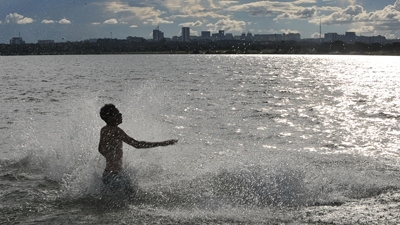Challenge
In the early 2000s, high population growth, rising water demand, and unabated pollution in many unplanned settlements in Brasilia were adversely impacting the quantity and quality of water resources.
Left unchecked, these impacts could potentially impose a high cost on the expansion of basic services, erode the quality of life and health of the most vulnerable population, and ultimately undermine the sustainable development of the region. One such settlement was Vila Estrutural.
With 6,500 families, Vila Estrutural was by far the largest and most critical settlement in social and environmental terms. Its explosive growth started in the early 1990s when a group of waste pickers built the first houses alongside the solid waste landfill. Its privileged location, about 7 km from the center of Brasilia and along a main highway, served as an attraction for informal settlers.
Vila Estrutural was a challenge from an environmental perspective because it borders the Brasilia National Park, significantly impacting the park and altering the flora and fauna. Also, Lake Paranoa was being affected, as the community produced a major pollution load draining into the lake. The GDF’s policy for addressing unregulated low-income settlements at that time was to demolish houses and resettle the population in regularized subdivisions.
Previous governments had unsuccessfully tried to demolish Vila Estrutural, with one such attempt triggering street violence resulting in four deaths.
Solution
The World Bank partnered with the GDF in a socially inclusive and integrated approach to environmental protection. The main Bank instrument used to address the water quality issues in Brasilia was the IBRD investment loan, which financed the installation of sewerage systems in key areas where water bodies were being polluted and the upgrading of an informal resettlement adjacent to a national park and water basin.
The upgrading effort was the first of its kind for the GDF, and included roads, stormwater drainage, sewerage network, and community facilities.
The loan also financed institutional strengthening to promote sustainable urban development, such as a Geographic Information System (GIS) for urban projects, strengthening of the environmental licensing process, and the economic-environmental zoning of the Federal District.
Results
The main results of this project are the following:
- 40,000 low-income residents in Vila Estrutural benefit from upgraded infrastructure and community facilities;
- 56,000 low-income residents in Vicente Pires benefit from sewerage services;
- Over 1 million residents of Brasilia benefit from improved water quality; and
- Strengthened government capacity to promote sustainable urban development.
Bank Group Contribution
The Bank contributed to the broader Brasilia Environmentally Sustainable Program through this IBRD loan of US$ 57.64 million.
Moving Forward
The GDF is currently seeking external funding for Phase II of the Program.
Beneficiaries
In 2001, Vila Estrutural had the region’s highest crime indicators. Some families reported that they were forced to leave their houses by criminals who would then sell the houses at a profit. Children from Vila Estrutural attend schools in other neighborhoods, but suffered discrimination because they were regarded as delinquents.
The project resulted in an overall improvement to the quality of life for residents in Vila Estrutural in terms of access to infrastructure and community services. In addition to the investments carried out under the project, the GDF also established several community facilities including, among others, a community restaurant, a large sports center, and police facilities.
